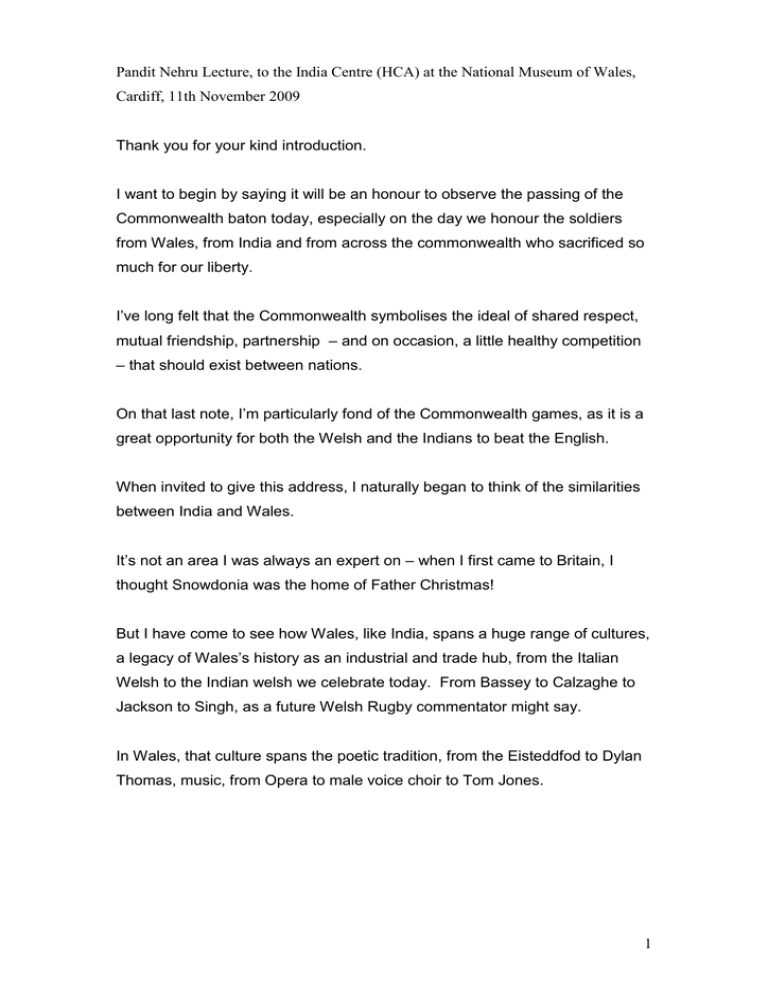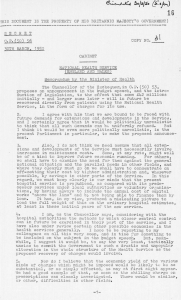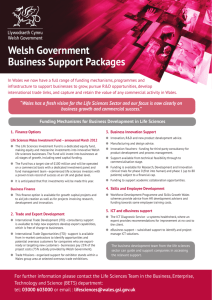Pandit Nehru Lecture, to the India Centre (HCA) at the... Cardiff, 11th November 2009
advertisement

Pandit Nehru Lecture, to the India Centre (HCA) at the National Museum of Wales, Cardiff, 11th November 2009 Thank you for your kind introduction. I want to begin by saying it will be an honour to observe the passing of the Commonwealth baton today, especially on the day we honour the soldiers from Wales, from India and from across the commonwealth who sacrificed so much for our liberty. I’ve long felt that the Commonwealth symbolises the ideal of shared respect, mutual friendship, partnership – and on occasion, a little healthy competition – that should exist between nations. On that last note, I’m particularly fond of the Commonwealth games, as it is a great opportunity for both the Welsh and the Indians to beat the English. When invited to give this address, I naturally began to think of the similarities between India and Wales. It’s not an area I was always an expert on – when I first came to Britain, I thought Snowdonia was the home of Father Christmas! But I have come to see how Wales, like India, spans a huge range of cultures, a legacy of Wales’s history as an industrial and trade hub, from the Italian Welsh to the Indian welsh we celebrate today. From Bassey to Calzaghe to Jackson to Singh, as a future Welsh Rugby commentator might say. In Wales, that culture spans the poetic tradition, from the Eisteddfod to Dylan Thomas, music, from Opera to male voice choir to Tom Jones. 1 In India, there is the same legacy of an oral tradition of philosophy and spirituality that results in modern poetry, music, tracing from the Ramayana and Mahabharata to the Krittibas Ojha and thence to Tagore and Dutt.1 There are quite a few other similarities. The citizens of India and Wales share a reputation for talkativeness, exuberance, and even, on occasion, long windedness. More importantly, we share affection for good food and drink. So the good news is that the wise organisers of this event have put this speech before dinner, so the love of food will outweigh the urge to talk! The other trait we share is one I am more grateful for each year – a respect for experience, not for its own sake, but because it often brings with it wisdom, thoughtfulness and compassion. Those qualities typify the First Minister. Sir, it’s a particular honour to have you here tonight. I’m sure that by now, you’re sick of being praised at every event you go to, but allow me to say just this - I’ve heard on many occasions, from companies, organisations and individual leaders from India and around the world, how your belief in Welsh industry and business has impressed them and encouraged them to invest in Wales. Giving the Nehru lecture is a particular honour for me, as I was educated at the Indian Institute of Technology at Kharagpur, a university founded because of Pandit Nehru’s belief in technology as vital to the growth of modern India. 1 I’ve used Bengali poets here. I thought it would be more suited to you personally. 2 Nehru’s belief in the liberating power of innovation has shaped my whole career, and in thinking of the future of India, I am very conscious of Nehru’s passion. I believe scientific research, practical innovation and technology are the engines that will drive India’s future – and which will also drive Wales’s links with India. I suppose a Welsh sceptic might wonder why the Welsh should care about the economic situation in India. After all, even though Welsh exports to India increased by 57% last year, India is only the twenty-fifth largest destination for Welsh exports, with a total export value of £85 million2. That’s slightly less than Poland. Equally, an Indian sceptic might wonder what a country with a population of three million can offer a nation of a billion souls. Yet I believe India and Wales are linked by history, by expertise, and by a common future. First, India and Wales’s history offer each other lessons and warnings. Next, India’s current growth and Wales’s heritage give both countries opportunities to expand that must be seized. Finally, in both India and in Wales, the future rests on our response to shared challenges, risks and opportunities. We will achieve more if we work together. Welsh History. 2 Statistics for Wales note “Welsh Exports: Second Quarter 2009”, P4, table 2. 3 Today, we are talking about a country that has experienced huge changes. It’s seen a doubling of population in a single lifetime. It’s seen huge new industries spring up and technical innovations driving rapid growth. It’s seen huge population shifts as people move from villages to new economic centres, shifting the economy decisively from agriculture to industry. And of course, all this change has meant economic, religious, social and political tensions that have, on occasion, become tragedies. I am, of course, talking about Wales. The Wales of the Industrial revolution experienced massive growth, as new technologies in steam, copper, coal, slate and iron joined expanded trade networks like rail and ports. Wales’s population doubled in fifty years. Innovation drove industry forward at breakneck speed. That growth fuelled both economic power and social inequality. India Today Like the Wales of the Industrial Revolution, India is now enjoying stunning growth. Like Wales, that growth is based on a combination of technological development, infrastructure, and access to global markets. Since 1991, Indian GDP in constant prices has grown from twelve billion rupees to over thirty six billion rupees. 4 GDP per capita at current prices has grown from over three hundred dollars to over a thousand dollars. Even allowing for inflation, GDP per capita has more than doubled in less than twenty years, increasing from thirteen thousand rupees in 1991 to thirty thousand rupees in 2009. At the same time, the population of India grew by three hundred million. In other words, in just under two decades, India has added a hundred Wales’s to its population, and still doubled the income of everyone in the country.3 These are staggering numbers. They are even more remarkable when you consider that the period we’re talking about has been book-ended by two enormous economic crises. The latest economic storm – precipitated by the Credit crunch – we all know about. India has weathered the crisis well. GDP growth in 2008-9 was a healthy 6.7% and the latest data suggests economic growth in 2009 will be of the order of 9%. The other crisis is hardly known in the West, yet it is much more important to understanding India’s current success. Before 1991, India’s economy had been under-performing for a generation. India pursued a policy of import substitution, of preventing foreign investment and importation to allow domestic businesses to succeed. 3 International Monetary Fund, World Economic Outlook Database, October 2009 5 In the automotive sector, this meant that manufacturers had a captive market. There was little pressure for manufacturers to innovate when the waiting times for existing products were measured by years. At the same time, much economic activity was state directed. For example, in the Steel industry, state owned Hindustan Steel, competed with two licensed private manufacturers in a market with prices set by central government in order to reduce pressure on steel consumers. Unsurprisingly, Hindustan Steel struggled for decades, finding it impossible to increase prices, invest in plant modernisation or develop new processes, while its competitors were constrained by the prices set by the government. All of this led to decades of sluggish growth. India’s GDP growth was stuck at around 3.5 percent per annum between 1950 and 1980.4 The Eastern tigers were outpacing Indian growth but there were powerful interest groups against reform. Governments, unions, public sector workers and powerful domestic manufacturers all had a strong interest in preserving a secure, if slow growing, India. The decisions that shaped post independence India may not have been economically perfect, but they were not irrational. Most importantly, the focus on the welfare of the citizenry meant democracy worked. This achievement alone – Hundreds of millions growing up free of dictatorship, oppression and military rule – is one that must weigh heavily in the balance. An emphasis on social solidarity created an education system that produced managers and technologists of the highest quality. 4 Indian export and economic growth performance in Asian perspective, S. D. Tendulkar, ICIER, Dec 2000. P11-14 6 Even as India’s economy struggled, Indians were climbing the ranks of the World Bank, leading University research, developing expertise in engineering and skilfully leading major industrial corporations. These technocrats had companies to run because import substitution created a network of Indian businesses that had sufficient size and experience to compete on the global stage when trade liberalisation came. Finally, restriction on foreign investment lasted long enough to make India’s domestic market attractive enough to foreign investors that they were willing to enter joint ventures with Indian companies in order to access Indian consumers. Ideologically too, India could justify its position. Immediately after independence, foreign investment would have come at a high price. If Indian business giants were isolated, they were at least Indian. Profits stayed at home and were re-invested in India. The downside was anaemic growth. By the 1980’s, it was clear that reform was needed, but people were cautious. Many business leaders and politicians privately echoed St Augustine “Lord, make India free trading,, but not yet”. So India’s first economic reforms were piecemeal and imperfect. This process was symbolised by the success of Maruti Udyog, a state joint venture with Suzuki. In 1982, joint ventures with state corporations were permitted. In 1983 the Maruti 800 car was launched. Suddenly, a Japanese-style hatchback proliferated on roads previously dominated by the Hindustan Ambassador. 7 The Maruti 800 was India’s top selling car for twenty years. Two and a half million were sold. Maruti came to symbolise a type of liberalisation, but was still state controlled and its competitors were heavily restricted. This gradual lifting of restrictions was a success – Indian growth rates increased to 5.8% across the eighties and both exports and consumption grew rapidly. Yet these steps towards liberalisation also highlighted India’s weaknesses. Indian exports grew, but imports grew faster. On top of that, India’s government debt expanded as public employees demanded their salaries increase with inflation and the private sector. To keep growing, India needed three things from foreign sources. Cheap petrol – to fuel domestic economic growth. Cheap loans - to fund India’s growing deficits. and Western growth, to increase Indian exports to the west. While all three were in place, all seemed well. As India grew, the volume of Indian petroleum imports increased by more than 40 percent from 1986 to 1990 while India’s external debt nearly doubled from some $35 billion at the end of 1984/85 to $69 billion by the end of 1990/91. But in 1991 petrol and debt suddenly became very expensive. A combination of the gulf war and an American recession meant the cost of imported petrol leapt up, while banks had little capital to lend India’s government. 8 The result was a balance of payments crisis that shook the country to its core. Suddenly, India could not afford to pay its way. The choice seemed to be depression or debt default. There is a story that the reserve bank of India was asked mid-crisis to move its Gold reserves overseas in order to secure an emergency loan from the IMF. On the way to the airport, the only truck capable of carrying the gold broke down. The fate of India’s entire economy rested on whether panicked mechanics would be able to patch up a thirty year old truck. The story may be apocryphal, but it neatly encapsulates the eventual solution to India’s crisis. In desperation, India turned to a group of economic mechanics – a group of technocrats gathered around newly appointed Finance minister, and India’s current Prime Minister, Manmohan Singh. India devalued the rupee across 1991, but more importantly, the Government took steps to prevent recurring balance of payments crises. Attempts were made to reduce the state deficit, price controls were gradually removed, and foreign investment, domestic industry and taxation rates were all liberalised. You no longer needed a licence from the government to make machine tools, if you thought you could make a good product and a good profit, it was up to you. 9 The impact of these changes was swift and astonishing. From 1994 to 2000, India’s GDP growth averaged 7% per annum, despite the Asian financial crisis of 1997. That growth rate has since improved, as reforms have been extended. India achieved growth rates of over 9% per annum in 2005, 2006 and 2007, over 7% in 2008 and is projected to reach around 9% again this year. Remember, this level of growth is achieved in the middle of a near- global recession. No longer is India dependent on cheap petrol, cheap debt or strong Western demand. The Indian economy is being driven primarily by internal demand and internal growth. It’s important to know what kind of growth we’re talking about. For many years, people in the West mostly associated Indian economic growth with call centres and back office facilities. While these industries are important, the attention they receive risks missing the wider shifts in the Indian economy. The real growth engine of India is not the ability to staff a call centre but a combination of high educational standards, a focus on technological innovation and the need to satisfy the increasing wealth of the Indian consumer. It is this combination of innovation and consumer demand that has driven growth in the automotive sector, in pharmaceuticals, in computing, in telephony, in steel, aerospace, and road and rail transport. The most visible symbol of India’s growth through innovation and a strong domestic market is the global expansion of Indian companies. 10 Whether it is Tata Steel, Reliance, Infosys, Wipro or a host of others from steel to IT to bioscience, Indian companies have rapidly established themselves as world leaders, bringing with them substantial investment in capital and research, aggressive plans for growth, and a belief in the value of innovation and technical superiority. That has implications for every country in Europe, including Wales. I’m sure everyone is familiar with Tata Steels purchase of Corus and Tata motors’ acquisition of Jaguar Landrover, but this process runs much deeper than any single companies commitment to making the tough decisions and investment needed to revive famous western companies. Take a company like Wockhardt UK, an Indian owned company who employ more than 1,500 employees in Europe, and have chosen to make their European HQ in Wales. Wockhardt UK’s Wrexham site employs 350 people, is a leading exporter and is helping to grow the company at twice the rate of growth of the pharmaceutical industry in the UK. This is an example of Indian success creating Welsh jobs. So how should Wales ensure it gains the maximum benefit from this expansion of the Indian economy? First, there is the need to welcome Indian Investment. Just as the Japanese found a home in Wales in the eighties, Wales should seek out and welcome Indian investment today. I know that the Welsh Assembly Government have made this a special focus, with trade missions and a specialist team working on Indian business and trade, and this should continue. 11 Here, Wales is helped by its Industrial history. Wales was home to some of the first coke furnaces in the world, and the first load bearing locomotive. These innovations worked through the economy, leading to ever higher concentrations of production. In turn, the new industries drove further innovation. It is no accident that Merthyr Tydfil is the site of the world’s first iron girder bridge5, built in 1794 by Watkin George, a Welsh carpenter turned engineer, and still standing today. That small bridge inspired later engineers like Telford, and is a monument to both industrial innovation and the skills of the Welsh engineers. Over the years, these industries created a network of expertise in sectors as diverse as railways, aerospace, steel, mining, engineering and energy. These sectors are vital for Indian growth. So it is Wales’s engineering heritage that makes Wales an attractive partner to Indian businesses today. The growth opportunities India offers are phenomenal. A recent Goldman Sachs focussed on one component of future Indian growth – the need for infrastructure. They reported that “India would need to more than double its electricity capacity, increase the lengths of it’s road by half, and add substantially to it’s railway, irrigation, ports and airports to keep pace with economic growth.”6 Goldman Sachs concluded that India needs to invest one point seven trillion dollars in infrastructure spending alone. 5 6 International canal Monuments list: http://www.icomos.org/studies/canals2b.htm Goldman Sachs Global Economics Paper 187, P8 12 That money will be spent on ports, on power stations, on power plants, on roads, on sewers, on rapid transport, and a host of other projects. In one decade. For a Welsh railway engineer, steel maker, or energy sector manufacturer, these numbers could represent the future of your business. Take a company like Carpenter and Paterson in Mid Wales. Despite the recession, this familiy owned pipes supports manufacturer have doubled their exports. How? A large part of the answer lies with their grasp of the opportunity in India’s infrastructure expansion. Carpenter and Paterson have secured contracts to supply equipment to one of the largest new petrochemical refineries in the world. The company is sending its engineers to India to oversee the installation of its products in the new refinery at Jamnanar. Those are Welsh jobs secured by a legacy of expertise, India’s current expansion and the vision of a Welsh company. There is one more lesson from the industrial revolution we should learn. In Wales, the industrial revolution showed the capability and capacity of a people regarded by an out of touch elite as uneducated, even backward. The “Treachery of the Blue Books”7 showed that nineteenth century Wales was regarded as having ill-educated workers poorly equipped to transform with the world around them. This is despite the brilliance of men like Watkin George and dozens of other innovators in Welsh industry. 7 Frank Price Jones, 'The Blue Books of 1847', in Jac L. Williams and Gwilym, Rees Hughes, eds, The History of education in Wales (Swansea, 1978), 127-44. 13 This characterisation was unfair and wrong, but it gives us an important lesson for today – Indian engineers, students and companies are just as capable of producing innovation and genius as the pioneers of the Welsh industrial revolution were a hundred years ago. There are those who will tell you that the west just needs to focus on the top of the value chain, on high value added technology. There is a hidden implication in that message – that somehow the Indian businesses will not be able to focus on the complex and the high value. We know that the world did not pay enough respect to the genius of Wales in the first industrial revolution. So we must always be on our guard against that kind of cultural bias reoccurring. Just as Welsh engineers from Merthyr to Ffestinnog showed up the lazy prejudices of the authors of the blue books, anyone who thinks that Indian firms won’t be able to innovate are in for a nasty surprise. Go to Harvard, or MIT, or CalTech or meet the 2,000 Indian students now studying in Wales. Those people, and the firms they build, won’t be content with staying low down on the value chain. India is more than capable of producing globally innovative products. It is doing so already – in industries as varied as automotive, bioscience, space and genetics. So for success for Wales cannot lie in climbing the value chain alone, trying to keep one step ahead of the Patel’s - but by creating genuine partnerships – by innovating, investing and in researching alongside firms that understand the Indian domestic market and have the capacity to invest in research. 14 Success in India will rely on joint innovation and research. So the strength of Welsh Higher education will be one of the key drivers of Wales’s economic links with India. The breadth and quality of undergraduate teaching in the 12 Universities and Colleges of Wales is something special. To have 125,000 students in a population of three million is something extraordinary. For that population to include twelve thousand overseas students shows a real commitment to openness and internationalism. Making Wales a destination for global talent is key to future success. The second vital contribution of Welsh scientific research to economic growth will come through researchers setting up companies and putting their work to practical use. Here, applied technology – building links between universities, researchers and companies looking to innovate - will be a great attraction to Indian firms looking for partners to help improve their products and services. So it’s impressive to see projects like the Welsh Gene Park pushing forward the social and commercial application of science. I know expanding the commercial application of research was a key element of Wales’s “reaching Higher” programme. It is impressive that even with the recession, the number of profitable companies being spun out of Welsh Universities has increased by half over the last few years8. 8 http://www.hefcw.ac.uk/documents/about_he_in_wales/wag_priorities_and_policies/Reaching%20Hi gher%20Target%20spinout%20English.pdf 15 These companies will soon have an illustrious companion as Nobel Prize Winner Sir Martin Evans starts his research company. It is initiatives like these which will drive further growth in India and Wales. I believe Sir Martin’s partner is from a Sri Lankan background. So close to the perfect example of Indo Welsh co-operation! So the focus on education and on innovation in driving growth is as important for India and Wales today as it was a century ago. There is one final lesson from the past we must learn. In the Wales of the industrial revolution, there was huge growth, but also huge social inequality. So it is today in India, and policymakers must always bear that in mind if they wish to avoid an Indian version of the Rebecca riots. Alongside the race to prosperity there must be a race to expand opportunity. A century ago, that urge for shared prosperity meant a schoolhouse in every village, the founding of a University, and the radicalism of Lloyd George and the founders of the Labour party. In India today, the same impulse means a laptop for every child, investing billions into cutting edge research into preventing disease, finding answers to climate change and building educational networks that can meet the needs of millions of talented young people. That means India will need to export eager minds and import knowledge. India will be hungry for intellectual, as well as financial capital. Indian entrepreneurs will want to engage with those who are able to offer solutions in fields like healthcare, education, the environment and housing. 16 Again – this represents a major opportunity for those with the foresight to seize it. Whether in low cost housing or computer systems that cut the cost of training doctors, those who help find solutions to urgent social needs will be vital partners in India’s growth. Today, we live in a hectic world. It is a world where nations need to take the best of their heritage, innovate, and focus on meeting the needs of the world’s consumers with better products and services. If the world we live in is HECTIC, we must be too. To seize the chance of growth, a successful partnership should be Heritage based, Export focused, Consumer driven, Technologically focussed Innovative. and Collaborative These values have been are the cornerstones of India’s growth for two decades and more, and should be the mantra for anyone who wishes to prosper by India’s prosperity. As for me, I’m convinced that as India grows, Wales, with its industrial and research heritage, market knowledge and expertise to export, and it’s array of innovative, high tech industries, will prosper too. I wish both nations all the best in that journey. 17






